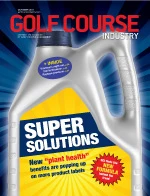 As the golf course superintendent at Minocqua Country Club in Minocqua, Wis., for the past three years, I prepare my course for the cold, snowy winter weather every year. Snow mold control is always a top concern for me as well as many other Wisconsin and across the northern Midwest superintendents. My first year in this region, I underestimated how much higher snow mold pressure is here as compared to North and South Dakota where I had worked.
As the golf course superintendent at Minocqua Country Club in Minocqua, Wis., for the past three years, I prepare my course for the cold, snowy winter weather every year. Snow mold control is always a top concern for me as well as many other Wisconsin and across the northern Midwest superintendents. My first year in this region, I underestimated how much higher snow mold pressure is here as compared to North and South Dakota where I had worked.
Fortunately, when I started at Minocqua in the fall of 2008, the prior superintendent had already planned and purchased products for a snow mold program that I was able to apply. If I had been in charge of the program, I likely would have selected a lighter application which would not have produced such great results under extreme snow mold pressure. These past three years have been a learning experience in controlling such extreme snow mold.
That same fall, we sprayed a fungicide on our greens, tees and fairways as our last chemical application of the year to combat snow mold. The following spring, I learned just how vital it is to have perfect chemical coverage from fall applications. As the snow melted and the turf started to grow, we noticed only half of the turf had been treated on one of our tees; the untreated area was completely dead. In other parts of the course, we noticed that even the slightest miss with the sprayer showed up in the spring.
Knowing we needed to eliminate the chance of skips and operator error, we decided to try splitting our application. The next fall we sprayed half of the application and then waited to spray the remainder of the application as close to the first snowfall as possible. We figured this method would guarantee at least 50 percent coverage if there were equipment or operator errors. Even though this meant we had to spray twice, this technique makes sense and works effectively since snow mold control is so vital for my course.
For many years the course had successfully used one particular product to control snow mold. However, due to my overall philosophy in chemical management, I am investigating different products. I believe if you use the same chemicals repetitively and do not vary the active ingredient, the snow mold can become resistant to the active ingredient and the product won't be as effective.
My search began last summer for an alternative product. I studied the snow mold control trials from the University of Wisconsin's turf research department to gain insight into the market. I turned to their site not only because of their reputation, but also because our current program was based on data from their trials years earlier.
After all my research, I decided to run an on-site trial with Bayer's Interface and Triton FLO. I liked the results I saw from the trial and after looking at several different products, I met with my Bayer sales representative to begin the trial in October 2010. It was 45 degrees when I applied Interface at 6 oz./thousand acres and Triton Flo at .85 oz./thousand acres to a bentgrass fairway and rough. To ensure proper application and full coverage, I used an air induction nozzle that sprayed 60 gallons/acre.
This combination of Interface and Triton FLO provided the competitive snow mold control I was looking for, with absolutely no snow mold breakthrough. The control lasted throughout the spring, even though we faced a rather cool spring that could have increased snow mold issues. In Wisconsin, where it remains cold long into the spring season, it's important that the sun's heat is drawn to the soil for quicker turf green-up to open our courses on time.
The Bayer trial demonstrated the treated areas were not only snow mold-free, but also had more vibrant color than I'd seen on my other fairways. The turf showed quicker green-up. At this time, my decision to switch to Bayer's snow mold program is driven by continued success of the product in the field as well as the cost-effective price in the present economy.
The author is superintendent at Minocqua Country Club in Minocqua, Wis.

Explore the October 2011 Issue
Check out more from this issue and find your next story to read.
Latest from Golf Course Industry
- Heritage Golf Group acquires North Carolina courses
- Editor’s notebook: Green Start Academy 2024
- USGA focuses on inclusion, sustainability in 2024
- Greens with Envy 65: Carolina on our mind
- Five Iron Golf expands into Minnesota
- Global sports group 54 invests in Turfgrass
- Hawaii's Mauna Kea Golf Course announces reopening
- Georgia GCSA honors superintendent of the year





